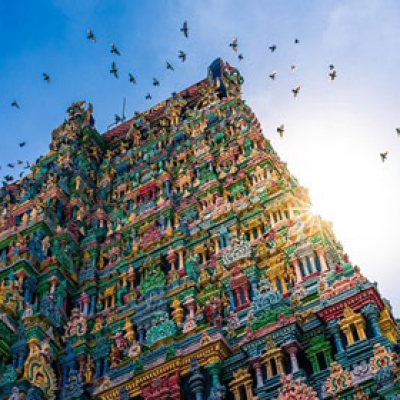
Meenakshi Amman Temple
Perhaps the most famous temple in Tamil Nadu, Meenakshi’s brightly painted and intricate gopurams (entrance towers) are often a symbol of Tamil Nadu. The origins of the temple may go back to the 2nd and 3rd centuries CE- Madurai itself is said to be upwards of 5000 years old, so there being a major temple here close to 2000 years ago is certainly logical.
Meenakshi Amman Temple - Madurai - Tamil Nadu
Pandya rulers lavished vast resources and the skills of countless craftsmen on the architecture of Meenakshi. All up there are 11 gopurams, the most attractive of them being the one at the southern entrance rising to a height of 45 metres with a parabolic curve.
The Golden Lotus Tank inside Meenakshi temple is surrounded by spacious corridors, the walls of which are covered with paintings depicting the lord's miracles. Adjacent to the tank are the Unjal Mandapam and the Kilikoottu Mandapam. The long rows of pillars here contain delicately-carved figures. There is a special Peetam in a six-pillared mandapam, where the coronation of all Nayak kings took place.
History Of Meenakshi Amman Temple
Madurai is mentioned by name on an ancient map dated to the 2nd century CE, and the temple is believed to have been started around this time. The temple as it appears today was started during the Nayak period and the city planned on a grid-pattern around the perimeter. Over the centuries Madurai was ruled by Nayak and Vijayanagara kings, the Kalambra and Pandiyan dynasties as well as by the Chola kings.
The idol of Meenakshi Amman is carved out of Emerald. During the time of war, invaders damaged the Shiva idol which is also present as the mark of remembrance of the history.
The nightly temple closing ceremony here is a must if you are in Madurai- the god and goddess are taken from the sanctum to their separate sleeping chambers and the whole event is accompanied by a cacophony of drumming, chanting and prayer